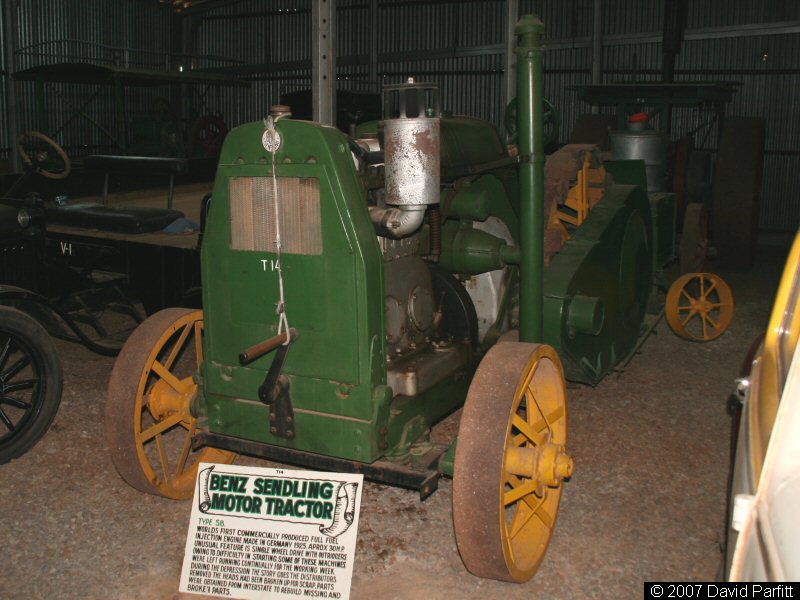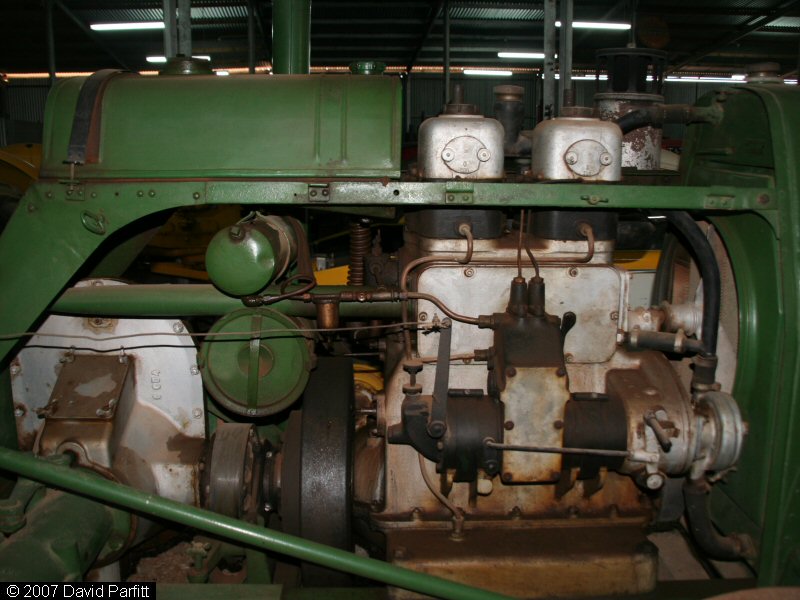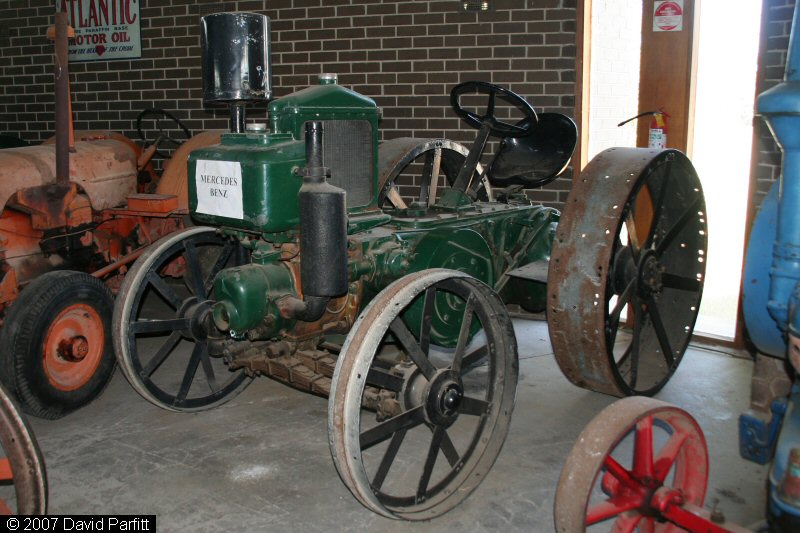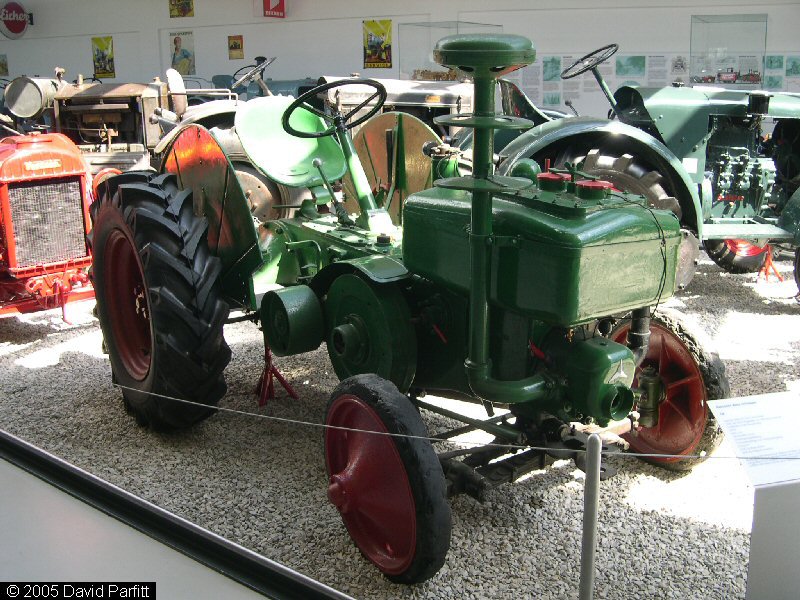Benz
Benz-Werke Gaggenau GmbH (part of Benz
& Cie.), Baden-Wurttemberg, Germany
Benz-Sendling Motorpfluge
GmbH, Unter den Linden 57/58, Berlin NW7 (later
Berlin-Charlottenburg), Germany
Daimler-Benz AG,
Stuttgart-Unterturkheim, Germany
History
Cover of brochure
for Benz-Gaggenau-Traktor
(click on image to
enlarge)
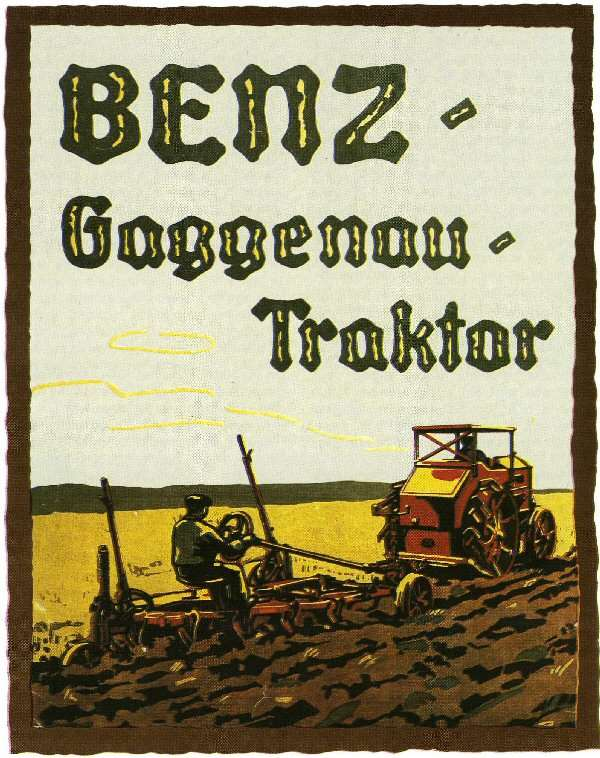 | Karl Friedrich Benz was born in Karlsruhe in the
south of Germany in 1844 and went on to study engineering at the
local university. In 1879 he was granted a patent for his own design
of two-stroke engine, and this was followed by numerous other
inventions in the developing field of automotive engineering. In
1883, Benz & Cie. was formed and two years later came the Benz
Patent Motorwagen, widely considered to be the first automobile. It
was powered by a four-stroke horizontal engine and ran on either gas
or petrol, and around twenty-five were built over the following
decade. Stationary engines and trucks were added to the product line
and the Benz & Cie. went from strength to strength, becoming the
world's largest producer of automobiles by the turn of the century.
Benz's first foray into tractor production came in
1907 when one of its board members, Georg Wiss, began work on a
motor plough design. Wiss had entered the company via a merger with
his firm, Suddeutsche Automobilfabrik GmbH (SAG), and he had already
been experimenting with tractor designs for several years by the
time he joined Benz. What emerged was a huge 65hp machine that
weighed more than six tons and featured a hinged plough frame that
was raised an lowered with engine power. Unfortunately this design
failed to impress Benz and Wiss was eventually ousted from the
company in 1910, going on to develop his motor plough designs with
Daimler instead. Meanwhile, Benz had moved all of its commercial
vehicle production to SAG's former Gaggenau plant and by 1912,
Benz-Werke Gaggenau had been created as a subsidiary of Benz &
Cie.
During the First World War, Benz's Gaggenau plant
produced trucks and artillery tractors for the army, and when
hostilities these designs were modified for agricultural and
road-haulage use. Of principal interest here is the
Benz-Gaggenau-Traktor, which first appeared in December 1919 and was
intended for use on the farm and road, as well as in the forestry
and construction industries. Powered by a four-cylinder petrol
engine (later diesel), this was a very modern-looking machine with
some consideration given to driver comfort. Nevertheless, it does
not seem to have sold in great numbers. At around the same time a
pure road-haulage tractor, the 50-55hp
Benz-Gaggenau-Strassenzugmaschine, was also produced, and it is
reported that Benz even converted some surplus WWI military tractors
to cable ploughing use.
The year 1919 was a significant one for Benz, as it
also saw the creation of Benz-Sendling Motorpfluge GmbH as a joint
venture with Motorenfabrik Munchen-Sendling of Munich. The latter
already had significant experience of tractor building, having
introduced their first design as early as 1909, and for the
Benz-Sendling project they were assisted by George Wiss acting as
consultant. The Benz-Sendling Model T3, which appeared later that
year bore all the hallmarks of a Wiss design, and was built by
Leipziger Automobil & Aviatik AG, a subsidiary company of Benz.
This three-wheeled machine with chain-drive to the rear wheel proved
much more successful than Benz's previous venture, and received a
silver medal at the German Agricultural Society's trials at
Magdeburg in 1919. Two years later production shifted to Mannheim,
and by 1923 a new version of the Benz-Sendling was ready, this time
fitted with a two-cylinder diesel engine an named the Model S6. Key
to this design was the gifted engineer Prosper l'Orange, who
pioneered the use of high-speed diesel engines in motor vehicles.
The three pre-production S6 tractors exhibited in East Prussia in
June 1923 soon found homes on some of the region's huge estates, and
the following year another 200 tractors were sold. A number of
improvements were introduced into later versions of the
three-wheeled design, most notably a more powerful engine, and sales
continued to grow, with some tractors being shipped as far afield as
Australia.
Cover of
English-language brochure for Mercedes-Benz Model OE (click on
image to enlarge)
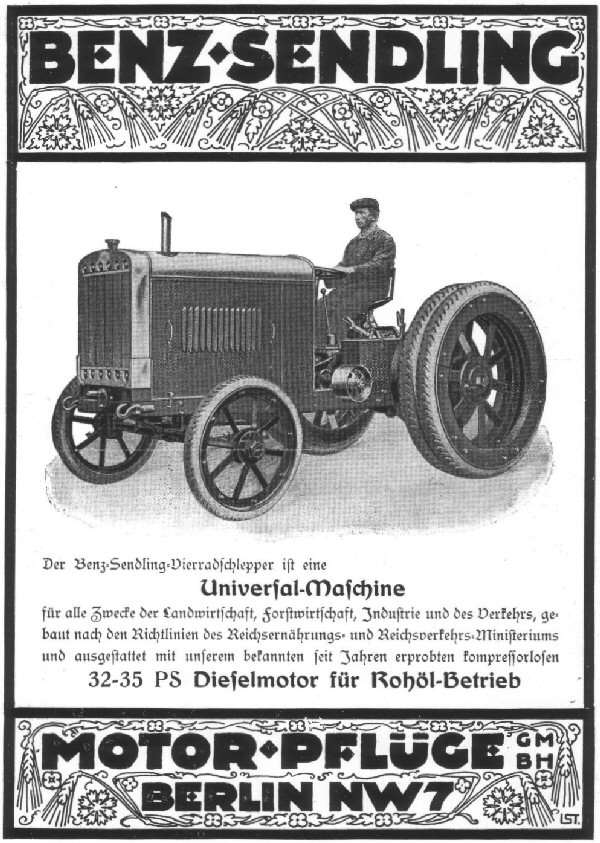 | In 1923
Benz joined forces with another experienced motor plough builder, Automobilfabrik Komnick AG of Elbing, to produce a
more conventional four-wheeled Benz-Sendling tractor, the Model BK
("BK" = Benz-Komnick). This basically consisted of a 32/35hp
Benz-Sendling two-cylinder diesel engine mounted on a Komnick
chassis. Fewer Model BK tractors were produced than the
three-wheeled designs, although an agreement was apparently reached
with J. & H. McLaren of Leeds in 1928 to build these tractors
under license in England. A McLaren-Benz Diesel Tractor was entered
in the World Tractor Trial at Oxford in 1930, but it is not clear
whether any such tractors were actually sold.
Meanwhile, back in Germany, Benz & Cie. merged
with Daimler-Motoren-Gesellschaft (DLG) in 1926 to form Daimler-Benz
AG and the "Mercedes-Benz" name and now-legendary three-pointed star
began to appear on the new company's products. By the late 1920s,
many German manufacturers were beginning to abandon multi-cylinder
engine designs in favour of the much simpler single-cylinder
horizontal unit popularized by Lanz. Daimler-Benz followed suit,
introducing the Mercedes-Benz Model OE Diesel Tractor in 1928. Also
marketed by the Benz-Sendling division, the Model OE represented a
radical change from Benz's earlier designs, with the emphasis now on
simplicity and economy with an eye towards the overseas market. The
single-cylinder crude oil engine was able to run on a variety of
cheap low-grade fuels and the tractor itself was simple to maintain.
A road version was offered with solid rubber or pneumatic tyres, and
an optional radiator and fan could be fitted for hotter climates.
However, the tractor was not as successful as Benz had hoped, due
mainly to the dominance of the Lanz and the prevailing economic
climate at the time. Some Model OE tractors did make it as far as
Namibia and Australia, and an attempt was made to break into the
French market by renaming it the "Helios", but by 1933 production
had come to an end. This marked the end of Daimler-Benz's
involvement in tractor building for quite some time, although the
company would later enjoy great success with its Unimog and MB-Trac
ranges.
Model Details
Benz-Gaggenau-Traktor
Benz-Gaggenau-Traktor units destined for
Romania
(click on image to enlarge)
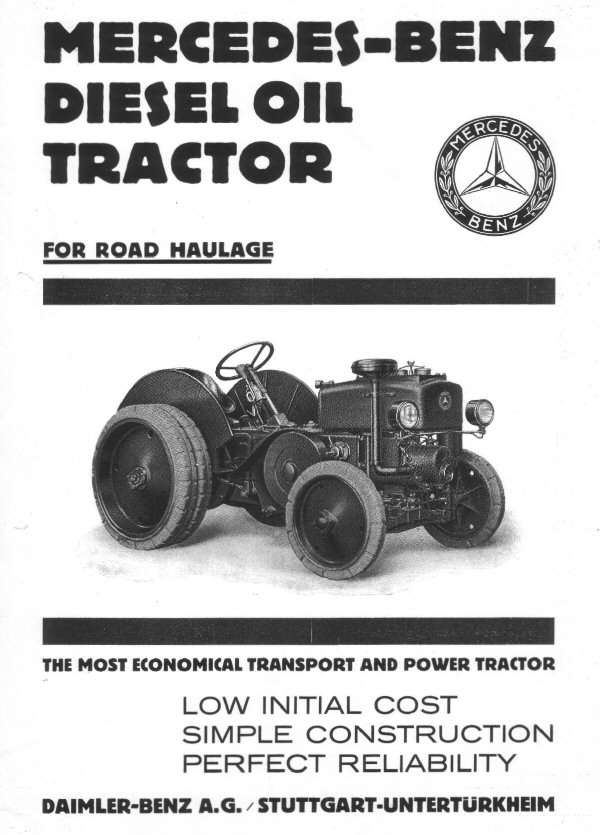 | Early examples of the Benz-Gaggenau-Traktor were
fitted with a four-cylinder petrol truck engine, almost certainly
the same 50hp unit with Zenith carburettor and Bosch high-tension
magneto that was used in the Strassenzugmaschine. In the 1920s this
was replaced by a similar-sized four-cylinder, four-stroke diesel
unit with a bore and stroke of 125 x 180 mm and also developing 50hp
at 1000rpm. The engine was started using an electric ignition system
until warm enough for self-ignition. Three forward speeds of 2.4,
3.6 and 6.6 km/h and reverse of 2.6 km/h were provided and the
tractor weighed 4000kg. Pinion drive to the rear wheels and chain
steering. A foot-operated multi-disc clutch and both hand- and
foot-operated brakes were standard equipment. A full electric
lighting kit with dynamo and battery was also an option.
Benz-Sendling T3
The three-wheeled
Benz-Sendling Model T3 used a two-cylinder engine of 135 x 185 mm
bore and stroke that developed 20-25hp at 800rpm and ran on benzene.
Cooling was via a fan and radiator with water pump, while
lubrication was automatic using a gear-driven oil pump. A
high-tension magneto was used for ignition and a patented starting
device and governor were standard. Only one forward and reverse gear
was provided, with chain-drive to the rear wheel, but the speed
could be varied from 3 to 4km/h by changing sprockets. All moving
parts were enclosed in dust-proof casings. The T3 weighed just
2000kg and was 4.71m long and 1.7m wide, while the drive wheel was
1.4m in diameter and the front wheels 0.85m. These front wheels were
sprung and featured automobile-type steering. Extension rims could
be attached to the ends of the rear axle to increase stability and
grip, but a pair of small auxiliary stabilising wheels was also
included with every tractor.
Benz-Sendling S6, S7 and S8
The
Benz-Sendling S6 was externally very similar to the T3, with the
same single-speed transmission, but the key difference was the use
of Benz's two-cylinder diesel engine. This was a compressorless,
pre-chamber design, which was started by turning over at reduced
compression with lighted touch paper inserted into the pre-chamber.
The bore and stroke were 135 x 200 mm and it produced 25hp at
800rpm. The engine was much smoother running than a direct-injection
diesel, but was let down by the complicated and unreliable starting
procedure, and stories are told of farmers leaving their tractors
running all night to avoid having to restart them in the morning!
The first three prototypes of the S6 appeared in 1922, with
production commencing the following year - over the next few years
the design was modified slightly and the horsepower increased in the
S7 and S8 models.
Benz-Sendling BK
Advertisement for
early version of Benz-Sendling Model BK (click on image to
enlarge)
The BK was a more conventional-looking design
than the S-series, but was ultimately less successful, despite being
offered in both agricultural and road versions. Introduced in 1923,
it used the same engine as its three-wheeled counterpart, but
featured a three-speed gearbox that gave it a top speed of 12 km/h.
It was also heavier, weighing in at 2800kg, and more expensive,
which no doubt accounted for the disappointing sales. Early examples
of the BK had a more rounded bonnet and radiator, as on the T3, but
later this was changed to a more angular appearance in line with the
S-series. The latter version was the one sold as the McLaren-Benz
Diesel Tractor in the UK in the late 1920s.
Mercedes-Benz OE
The 1928 Mercedes-Benz
Dieselschlepper Model OE represented a significant departure from
previous Benz designs. It featured a horizontal single-cylinder
engine of 135 x 240 mm that produced 24hp at 800rpm, although the
power output was later increased to 26hp when the bore was enlarged
to 150mm. The engine was still of the same four-stroke pre-chamber
diesel design as on previous models, but was now started using an
ignition cartridge and automatic compression release. It also
featured a removable cylinder head and liners, pressure-feed
lubrication plus an automatic centrifugal governor for speeds
between 300 and 800rpm. Hopper cooling was standard, but an optional
radiator/fan was also available at extra cost. Three forward speeds
of 3.2, 4.8 and 9.5 km/h and reverse of 4 km/h were provided on the
original agricultural version of the OE, although these were
increased for the road version to give a top speed of 12 km/h or
more if desired. A belt pulley and choice of either paraffin or
electric headlights were also optional extras.
|




